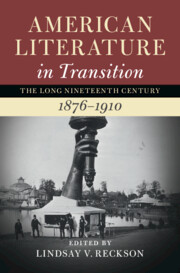Book contents
- American Literature in Transition, 1876–1910
- Nineteenth-Century American Literature in Transition
- American Literature in Transition, 1876–1910
- Copyright page
- Contents
- Contributors
- Series Preface
- Acknowledgments
- Chronology
- Introduction
- Part I Transitive States
- Part II Post-Reconstruction Aesthetics
- Chapter 6 Lyrics of the Color Line
- Chapter 7 Experimental Realisms
- Chapter 8 Species of Sentiment
- Chapter 9 The Microclimates of Regionalism
- Chapter 10 Racial Topographies and the Poetics of Mass Culture
- Part III Old Materialisms
- Part IV Immanent Techniques
- Index
Chapter 9 - The Microclimates of Regionalism
from Part II - Post-Reconstruction Aesthetics
Published online by Cambridge University Press: 24 August 2022
- American Literature in Transition, 1876–1910
- Nineteenth-Century American Literature in Transition
- American Literature in Transition, 1876–1910
- Copyright page
- Contents
- Contributors
- Series Preface
- Acknowledgments
- Chronology
- Introduction
- Part I Transitive States
- Part II Post-Reconstruction Aesthetics
- Chapter 6 Lyrics of the Color Line
- Chapter 7 Experimental Realisms
- Chapter 8 Species of Sentiment
- Chapter 9 The Microclimates of Regionalism
- Chapter 10 Racial Topographies and the Poetics of Mass Culture
- Part III Old Materialisms
- Part IV Immanent Techniques
- Index
Summary
Writing in 1932 for an audience of secondary school English teachers, Mary Austin lamented the harm that the modern search for the “great American novel” – a quixotic yearning that first emerged shortly after the Civil War – had inflicted upon late nineteenth- and early twentieth-century American literature. “Probably the American reading public has never understood,” Austin wrote, “that its insistence on literature shallow enough to be common to all regions, so that no special knowledge of other environments than one’s own is necessary to appreciation of it, has pulled down the whole level of American fiction.”1 Rather than “competently knowing” many different Americas through the “many subtle and significant characterizations” provided by regional literature, Austin argued, readers have lazily sought only a “broad, thin, generalized surface reflection of the American community and American character” (98, 99). Now that attention was finally turning back to regional writing, it was “rather surprising,” noted Austin, “to find critics in the United States speaking of regionalism as something new and unprecedented” when “strongly marked regional fiction” had flourished since at least the middle of the nineteenth century (98, 99). The task of the modern English teacher, she suggested, was thus to show young readers how to identify and appreciate “the best regional literature of our past” so that they may recognize “emerging instance[s]” of the genre in the present (107).
- Type
- Chapter
- Information
- American Literature in Transition, 1876–1910 , pp. 182 - 197Publisher: Cambridge University PressPrint publication year: 2022



